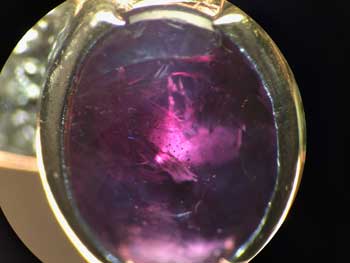Gem Enhancement’s slippery slope
Accounts of actual incidents can usually make a point more strongly than warnings or even statistics can.
This insurer’s claim experience shows the importance of examining details in the docs and consulting a reliable trained gemologist.
The claim
- The insured submitted a damage claim on a $10,000 alexandrite ring. The loss report stated that the gem had internal fractures, with some reaching the surface of the stone.
- The stone’s GIA lab report, dated some 16 years earlier, stated: "Evidence of clarity enhancement is present."
- The appraisal, from the jewelry retailer at time of purchase, gave the stone a clarity grade of SI and stated: “The clarity enhancement mentioned [on the GIA lab report] is oil residue from the cutting process.
So: Enhancement, as on the lab report? Or merely residue from cutting, as on the appraisal? And why does it matter?
Clarity enhancement is a treatment that improves the appearance of a gem, making the gem more salable. A common clarity enhancement is to fill a gem’s fractures with some non-gem material so the fractures become less visible—often invisible to the unaided eye. The fractures don’t go away, they are just camouflaged.
A fracture-filled stone still has its fractures, and fractures weaken a stone. Although alexandrite is a hard material, meaning it isn’t easily scratched, it is not tough. In gemologist terminology, that means the gem is less resistant to fracture damage, such as from bumping the stone on a hard surface or dropping the ring. If the gem already has fractures, damage from impact is even more likely.
The other issue is durability of the enhancement. The treatment that so improves the look of the gem may not be permanent. If the fill material breaks down, as may happen under the heat of a jeweler’s torch, for example, the fractures once again become visible.
For an expert opinion on this stone, the insurer sent it to a trusted gem lab for inspection by a Graduate Gemologist who is also a Certified Insurance Appraiser.
Gemologist’s report
The gemologist found:
- The stone did indeed have fractures.
- The existing fractures were consistent with a clarity grade of SI (slightly included), as given on the appraisal. (If fractures had not been there when the ring was purchased, the clarity grade on the appraisal would have been higher.)
- The GIA lab report of 16 years ago found evidence of clarity enhancement. (If fractures had not been there initially, there would have been no reason for clarity enhancement.)
Conclusion: Fractures in the stone became visible due to failure of a clarity enhancement.
Failure of an enhancement is inherent vice and is not damage for which the insurer is liable.
A related issue: Disclosure
The GIA lab is so respected around the world that it is regarded as the final arbitrator for disagreements over gem grading. Why did the selling jeweler’s appraisal contradict the assessment of the GIA lab, saying that the gem had “oil residue from the cutting process” rather than evidence of clarity enhancement?
Perhaps because the jeweler did not want to fully explain to the customer what this “enhancement” means:
- The gem has fractures or inclusions. Without “enhancement,” the stone would be much less attractive.
- The fractures have been filled with a non-gem material to make the flaws less visible.
- Special care may be required to maintain the attractive appearance of the stone.
- The treatment may not be permanent.
- Enhanced gems are worth less than non-enhanced gems of similar appearance.
The pleasant-sounding word enhancement is not sufficient. Full disclosure requires that the buyer be informed of just what that treatment means.
FOR AGENTS & UNDERWRITERS
Fracture filling and clarity enhancement — consider these terms flashing red lights, causing you to stop and look. Other qualities being equal, an “enhanced” stone is worth far less than an untreated gem of similar appearance.
 Fracture filling is a treatment done to conceal flaws in the gem. The fractures may not be visible to the unaided eye, but a trained gemologist with basic gem lab equipment can easily see them.
Fracture filling is a treatment done to conceal flaws in the gem. The fractures may not be visible to the unaided eye, but a trained gemologist with basic gem lab equipment can easily see them.
A gem with fractures, whether filled or not, is weak and susceptible to damage.
There is always the danger that gem treatments will not be disclosed—by the supplier, the dealer, the jewelry manufacturer, the retailer, or the consumer—either out of ignorance or as deliberate fraud. The insurer is at the end of this chain and could wind up grossly overpaying a claim.
All scheduled jewelry should have an appraisal from a reliable and trained gemologist appraiser who is independent of the seller.
Not all jewelers or appraisers are competent to appraise colored gemstones. The appraiser should be one who regularly deals in colored-gem jewelry and is able to recognize specific enhancements and understand their effect on valuation.
The best appraisal includes the JISO 78/79 appraisal form and is written by a qualified gemologist (GG, FGA+, or equivalent), preferably one who has additional insurance appraisal training. One course offering such additional training is the Certified Insurance Appraiser™ (CIA) course of the Jewelry Insurance Appraisal Institute.
FOR ADJUSTERS
Comb the appraisal and other documents for references to treatments or enhancements. A color- or clarity-enhanced stone should be replaced by a similarly treated stone.
On a damage claim, ALWAYS have the jewelry examined in a gem lab that has reasonable equipment for the job and is operated by a trained gemologist (GG, FGA+ or equivalent), preferably one who has additional insurance appraisal training, such as a Certified Insurance Appraiser™. The inspection can verify that the quality of the jewelry is as stated on the appraisal and lab report.
©2000-2025, JCRS Inland Marine Solutions, Inc. All Rights Reserved. www.jcrs.com




